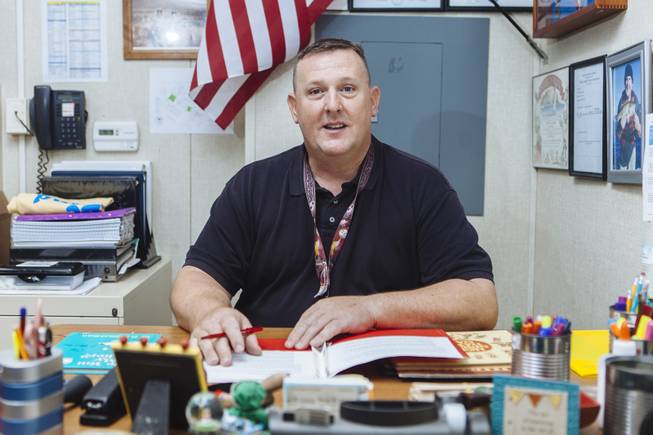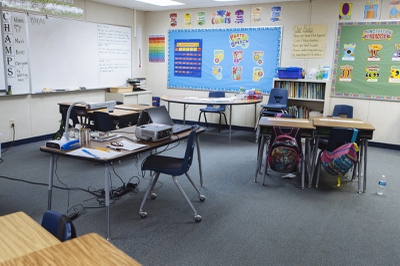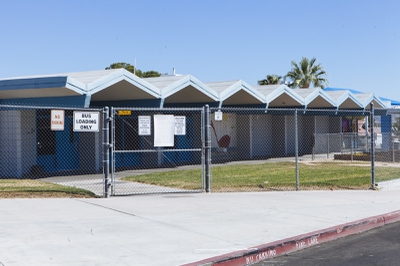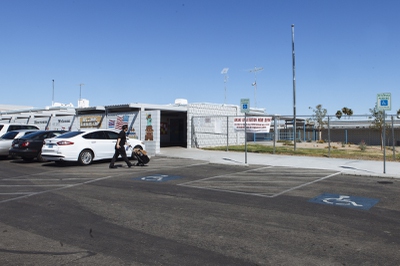
Teacher John O’Brien sits in his classroom Friday, Sept. 18, 2015, at Ruby Thomas Elementary School.
Wednesday, Sept. 23, 2015 | 2 a.m.
John O’Brien grew up in poverty like many of the 16 kids who file into his classroom every day at Ruby Thomas Elementary School.
The story goes like this: His father was working in a Burlington Industries factory in Ireland when his sleeve was sucked into a flax sorting machine and he was badly injured. Out of work, the family moved to the Irish town of Sneem, where they lived in a shack surrounded by weeds, tall grass and trees.
He keeps a photo of it tacked to his whiteboard, partly to remind himself of where he came from. The difference, he said, was his teachers. They pushed him and lifted him up.
“That’s the thing that saved me — I never forgot them,” he said.
The 44-year-old has been a teacher for four years but, unlike the hundreds of newly hired CCSD teachers who opt not to work in the city’s low-income schools, he’s already decided that he’ll never work anywhere else.
“This is where I’m needed,” he said.
The former Marine came to America during the 1980s, around the same time that President Ronald Reagan compared the country to a “shining city on a hill.”
It’s a vision he still believes in despite working out of an aging, portable classroom stocked with books, posters and supplies paid for out of his own pocket due to a threadbare school budget.
“We’re the richest country in the world. We have million-dollar missiles we can make and waste in training exercises, but look,” he said, gesturing at a handful of sand-colored portable classrooms constructed above the playground blacktop.
“I love this country. I think it’s the greatest country in the world,” he continued. “But this is just unfathomable to me.”
The school itself, sandwiched in the Paradise Palms neighborhood just behind the Boulevard mall, is aging and was built decades ago to house around half of the 820 kids enrolled today.
Around 80 percent of those kids are Hispanic, Latino or black. More than 90 percent qualify for free and reduced lunch and just shy of 50 percent are still learning English.
They are the same students hit hardest by Clark County’s ongoing teacher shortage, where retiring veterans in at-risk schools are leaving classrooms that the district’s newly hired recruits, given the choice of where to work, aren’t filling. The district started the year short around 900 full-time teachers across hundreds of schools.
Many of the school’s kids disappear during the middle of the year only to turn up at Petersen Elementary down the road, a product of their parents moving from apartment to apartment and crossing zoning lines.
Many come to school hungry, or distracted, or without basic school supplies.
As a result, O’Brien, who flies an American flag next to a case of military ribbons earned on deployments as an infantryman in Desert Storm, reverts to what he himself was taught decades ago as a directionless young man entering the service.
Whether they are walking to class or to lunch, his 16 second-graders walk double-file, each next to his or her assigned partner. If some students need to take a bathroom break while on their way around the school, he makes the rest of the class sit down and starts head-counting, a habit from his military days.
When one boy runs full speed from the bathroom back to the group, O’Brien makes him go back and walk.
“The first week I don’t teach,” he said. “I’m teaching structure: that this is how we do things.”
“I push them,” he said. “They thrive on that for some reason.”
His own kids, ages 14 and 12, are in public school. His wife is a veteran teacher at Tomiyasu Elementary. They live in Green Valley, near five-star elementary schools like Twitchell and Vanderburg. He could easily teach there, but he won’t.
“Those kids are taken care of. They have two parents in their house, they have money behind them,” he said. “These kids don’t have that. They need people like me and my wife to be there.”
He’s a staunch opponent of the district policy of allowing new teachers to choose where they want to teach, and feels that Superintendent Pat Skorkowsky needs to “put his foot down.”
A vast majority of the classroom vacancies are in low-income, inner city schools like Ruby Thomas, while the most well-staffed schools are in wealthier areas like Summerlin and Henderson.
“Those teachers are in their comfort zone,” O’Brien said. “They’re in that safe harbor, and they don’t want to venture out in the storm, and this is a storm.”
Every so often O’Brien will point to the photo of the shack on the whiteboard. His message is usually the same.
“There’s people out there in that city who want you to fail,” he will say. “They want you to pick up their dog poop, they want you to wash their clothes, they want you to babysit their kids.”
“But you can do a lot better than that.”




Join the Discussion:
Check this out for a full explanation of our conversion to the LiveFyre commenting system and instructions on how to sign up for an account.
Full comments policy